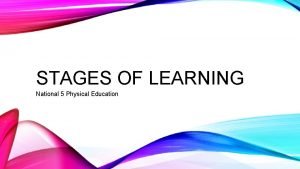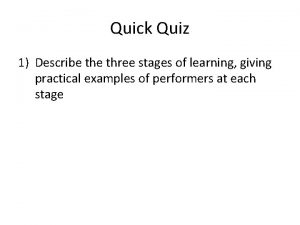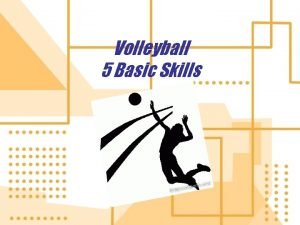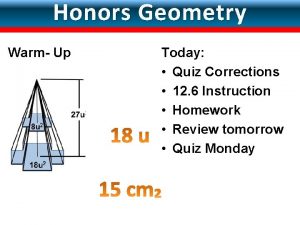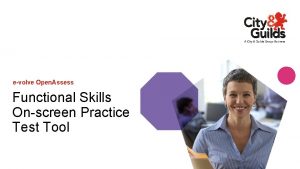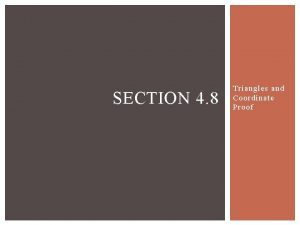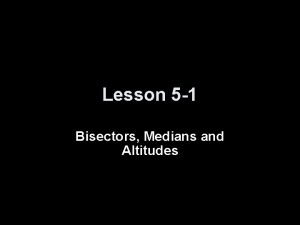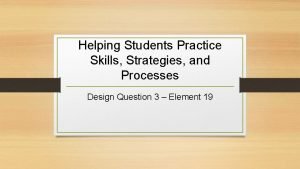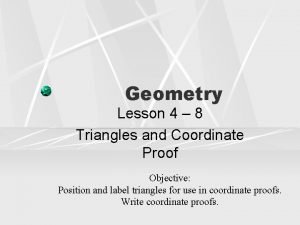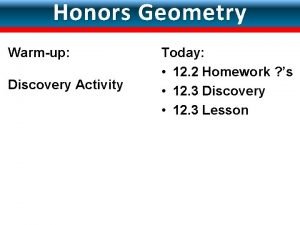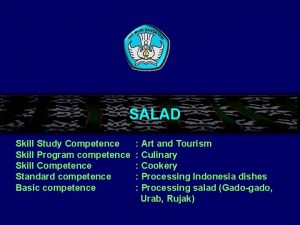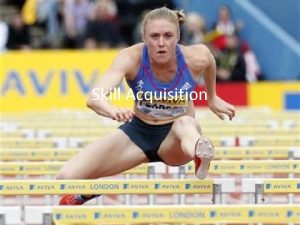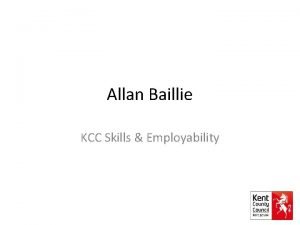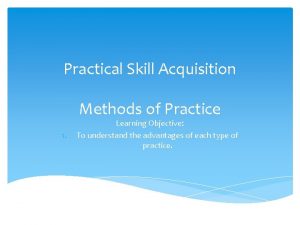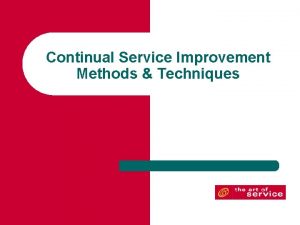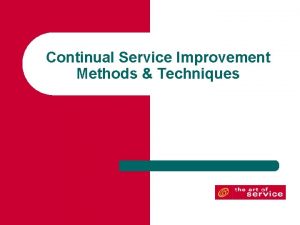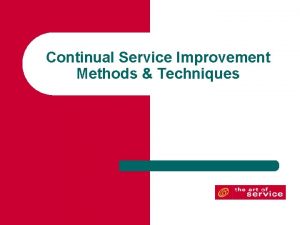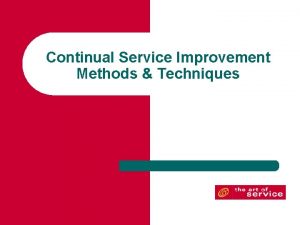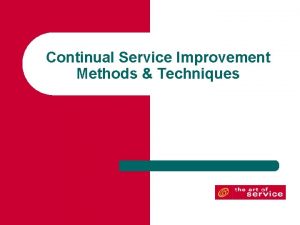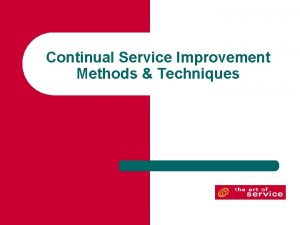Skills and Techniques Skill Learning Methods of Practice

















- Slides: 17

Skills and Techniques Skill Learning

Methods of Practice There are four main methods of practice that you need to know for physical education: • GRADUAL BUILD UP • WHOLE PART WHOLE • PASSIVE/ACTIVE PRACTICES • REPETIITIVE PRACTICES

Gradual Build Up Gradual build up is a useful practice method for learning complex skills. You learn the skill bit by bit. You build the skill up in stages. Often used when the skill is too difficult or dangerous to try. § § Gradual build up is a useful practice method as it allows you to: Make practices more demanding in small steps Develop confidence Make practices challenging but achievable Gear practices to your stage of learning

Gradual Build Up The best example for using the gradual build up method for an individual activity is the flight dive. Describe four different stages of building up to a flight dive in swimming

Gradual Build Up The best example for using the gradual build up method for an team activity is the Lay Up Describe four different stages of building up to a Lay Up in Basketball

Answers § Skill – Diving § Stage 1 – Sit on the edge of the pool with feet in the channel. Lean forward with head between the arms, with hands pointing towards the water. Topple forward into the water. § Stage 2 – One knee and one foot on edge of the pool. . Lean forward with head between the arms, with hands pointing towards the water. Topple forward into the water. § Stage 3 – Crouch down with both feet on the edge of the pool. Lean forward with head between the arms, with hands pointing towards the water. Topple forward into the water. § Stage 4 - Stand with both feet on the edge of the pool. Lean forward with head between the arms, with hands pointing towards the water. Topple forward and straighten legs to dive into the water.

Answer § Team Activity –Basketball § Skill – Right-handed Lay-Up § Stage 1 – Mark the take-off position on the ground and repeatedly perform a standing shot in off the back board. § Stage 2 – Mark the take-off position on the ground and repeatedly perform a jumping shot in off the back board. § Stage 3 – Take two steps back from the basket. Bounce the ball in front of you and catch it and take two steps, right foot then left foot, taking off from the take-off position on the left foot, before jumping and stretching up to lay the ball in off the back-board. § Stage 4 – Dribble the ball into the basket, to perform a full lay-up, jumping up off the left foot from the marked take-off position.

Whole Part Whole part whole is often used by performers who already have some experience of the activity. It works best when you can perform a version of the whole skill already. E. g. Front Crawl - Swimming Whole: Try the whole stroke i. e. using both arms and legs Part: With a float in hands, practise legs only to improve leg kick Whole: Return to the whole stroke again to see if stroke has improved.

PASSIVE/ACTIVE PRACTICES These are often useful to practise with a partner as they can vary the degree of opposition required to help you improve. E. g. Basketball – lay up shot 1. Solo practice ensuring foot pattern and ball placement is correct. 2. With a partner – receive pass from partner and perform lay-up shot. 3. Partner passes and then uses passive defence to mark you 4. Partner passes and then becomes an active defender who is trying to get ball.

Repetition Practices

Learning Skills Tasks 1. Choose one method of practice from list A and one from list B. Explain why you would use these methods of practice. (4) List A List B Shadow practice Whole-part-whole Small sided games Conditioned games 2. Choose two activities and describe, in detail, how you used these methods of practice to develop a skill. (Give specific details of a practice that you have used). (4)

Learning Skills Tasks 3. Gradual build up is one method of learning and developing skills. i) What is meant by gradual build up? ii) Explain why you would use this method /2 /2 4. Select two different skills where you used gradual build up. Choose an individual activity, a skill or technique. Describe how you learned to perform this skill or technique. Firstly I, /1 Then I, /1 Finally I, /1 5. Choose a Team activity, a skill or technique. Describe how you learned to perform this skill or technique. Firstly I, /1 Then I, /1 Finally I, /1

Simple Skills Few Sub-routines e. g. Set Shot Few judgments to be made Physically Undemanding EASY/SIMPLE SKILLS Simple order of movements Little co-ordination needed Easy Environment e. g. Indoors One movement at a time

Simple Skills HIGH SERVE SET SHOT CHEST PASS PUSH PASS SIMPLE SKILLS HEADING HEADSTAND

Complex Skills e. g. Lay-up in Basketball Physically Demanding Many Sub-routines Many judgements to be made COMPLEX SKILLS Co-ordination is vital Many movements at the same time

Complex Skills Butterfly stroke Basketball lay-up High jump Volley Goal Keeper save

Learning Skills Exam Questions 1. Whole – part – whole and gradual build-up are two different methods of learning and developing skills. Explain why you used each method. (2)x 2 2. Choose an activity. Choose a skill/technique that could be improved using whole/part/whole. Describe what you did to improve this skill/technique using whole/part/whole. (2) ii) Now choose a different method of developing skills. (1) iii) Describe how you used this method to improve a skill/technique in an activity of your choice. (2) iv) Why was this an appropriate way to develop this skill/technique. (1)
 Soft skills meaning
Soft skills meaning Cuadro comparativo e-learning y b-learning
Cuadro comparativo e-learning y b-learning Wax pattern fabrication pdf
Wax pattern fabrication pdf Stages of learning pe
Stages of learning pe Learning targets knowledge, reasoning, skill product
Learning targets knowledge, reasoning, skill product Describe the three stages of skill learning
Describe the three stages of skill learning Cookery skills techniques and processes
Cookery skills techniques and processes Fundamental skills of volleyball
Fundamental skills of volleyball Intrapersonal skill adalah
Intrapersonal skill adalah 12-6 surface areas and volumes of spheres
12-6 surface areas and volumes of spheres City and guilds secure assess
City and guilds secure assess What proof uses figures
What proof uses figures 5-1 skills practice bisectors medians and altitudes
5-1 skills practice bisectors medians and altitudes Helping students practice skills strategies and processes
Helping students practice skills strategies and processes What proof uses figures on a coordinate plane to prove
What proof uses figures on a coordinate plane to prove 11-3 volumes of pyramids and cones
11-3 volumes of pyramids and cones 1-2 line segments and distance answer key mcgraw hill
1-2 line segments and distance answer key mcgraw hill Lesson 11-3 surface areas of pyramids and cones
Lesson 11-3 surface areas of pyramids and cones



